ARTICLE

A heavy-weight deck, full of meanings and deeply rooted in ancient designs and worldviews.
I. The Deck's roots
Made for U.S Games Systems in 1984, the deck reproduces Cary-Yale and Pierpont Morgan-Bergamo cards collections, which group some of the Visconti-Sforza's Tarot cards from the XV c. The latter represents the Renaissance noble class of Mylan, especially the members of the Visconti and Sforza families. Although no complete deck of that Tarot has survived over time, the designs have influenced the visual composition, numeration and perspective of modern decks. Scapini's deck came out from those representations as well as from Mantegna's Tarot worldview.
 The Pierpont Morgan-Bergamo cards collection was made in 1451, approximately. As the Ace of Cups and the Knight of Swords display, Scapini's minor arcana (Ace to X) are all painted in creme color and include flowers and vineyards designs. Scapini's major cards and court figures also show golden backgrounds which follow a 3-row and 3-column grid distribution, always with the mentioned background wall and a floor, as it can be appreciated in the Knight of the collection (exceptions are The World XXI, with no ground, and the Queen of Coins, the only card with two backgrounds).
The Pierpont Morgan-Bergamo cards collection was made in 1451, approximately. As the Ace of Cups and the Knight of Swords display, Scapini's minor arcana (Ace to X) are all painted in creme color and include flowers and vineyards designs. Scapini's major cards and court figures also show golden backgrounds which follow a 3-row and 3-column grid distribution, always with the mentioned background wall and a floor, as it can be appreciated in the Knight of the collection (exceptions are The World XXI, with no ground, and the Queen of Coins, the only card with two backgrounds).

About the Mantegna's Tarot, it seems it had inspired The Medieval Tarot's drawings (TMT), too. But the Mantegna is based on a specific worldview, with cards motifs going much beyond Scapini's Tarot mundane life. The Mantegna was made between 1465 and 1470 (contemporary to Visconti-Sforza's deck) and has been attributed to Andrea Mantegna, Baccio Baldini (goldsmith and engraver) and other artists related to Francesco del Cossa (all of them from the Italian School of Ferrara). The school's style in the Renaissance Age displayed emaciated bodies and faces, of static and painful expressions.
Mantegna's deck is made of two series of 50 cards each, grouped in 5 sets according to the subjects they refer to. Group A (cards 41-50) refers to the 7 planets known by those times, the octave sphere (fixed stars), the Primum Mobile (First Cause) and the Prima Causa (God). Group B (cards 31-40) portrays geniuses and virtues. Group C (cards 21-30) reflects the 7 liberal arts, along with Philosophy, Poetry and Theology. Group D (cards 11-20) shows the 9 muses of arts, and Apollo. And Group E (cards 1-10) represents the medieval social hierarchy, from beggar to Emperor and Pope.
About the groups, Adam McLean in An Hermetic Origin of the Tarot Cards? says they represent the relation between Macro-cosmos (Group A) and Micro-cosmos (Group E). The other groups are pathways of development, inspiration and transmutation. In his article, McLean includes each group composition, with specific symbols and associations, and also offers a brief comparison with modern cards, for example by pairing the medieval Artisan (card 3, Group E) with The Magician.
indexII. Profusion & Dualism
Mantegna's worldview can be traced in Scapini's deck, for example in the inclusion of animals and in a widely present dualistic perspective in the concepts and designs. Along with a lot of biblical references, any reading should start from considering falls and ascensions. Duality is also appreciated, for example, in the color distribution and yin-yang principles attached to sex characteristics (golden is for male and silver is for female; in the Two of Swords, yin is for female and is opposite to male yang). All of this can also be seen in some other specific cards:
- The Popess II includes the representation of a demonic serpent offering an apple from one of the columns, which is supported by a black sphynx that, at the same time, represents the female side in life.
- The Pope V includes representations of vices in the inferior area of the card, which are considered as sins to be defeated for triumphing over them.
- The Lovers VI represent vices and virtues either, the first ones associated to a sunny pleasant pathway, and the second ones to a hard ground pathway.
- The Chariot VII clearly opposes spirituality to sensuality, and thinks of them as two natural human impulses, which have to be controlled and harmonized. This is represented by two horses, one white and the other one black, one of them oriented upwards and the other one downwards, with tails forming a kind of a winged seed when joined.
- Temperance XIV shows again the separation of sexes in the colors and symbols on vessels (Sun and golden for male, Moon and silver for female); the winged figure holding them is androgynous, which means the union of opposites happens in spiritual spheres, after ascending, and not in the mundane, sensual and physical experience.
- The World XXI assigns stars to the angel and the eagle (superior area of the card), whereas flames are on fire in the mundane lion and bull (inferior area).
- The Ace of Coins displays a main figure: a boy with a red band (Wands) enclosing his body and covering his eyes; the figure holds up a huge gold coin and has two blue wings (Cups); behind his head, and appearing at his shoulders' height, a second head shows up.

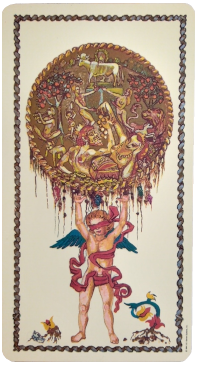 The difference between life spheres and experiences, inside of a worldview of low and high zones, also relates high heights to ascension by making blood sacrifices, as the crucifixion in The Hanged Man (XII) clearly shows. It can also be appreciated in Coins and Cups suits. Especially the Ace of Coins gives us a bloody first impression, although the deck's guidebook describes the hanging elements as roots, rocks and crystals. Inside of the coin, the classical richness of the material experience in the garden of Hesperides spreads blood out, and is supported by a child who doesn't see what he holds up or what it costs. Again, sensuality and material abundance seem to be associated to the absence of vision, young age and poured blood.
The difference between life spheres and experiences, inside of a worldview of low and high zones, also relates high heights to ascension by making blood sacrifices, as the crucifixion in The Hanged Man (XII) clearly shows. It can also be appreciated in Coins and Cups suits. Especially the Ace of Coins gives us a bloody first impression, although the deck's guidebook describes the hanging elements as roots, rocks and crystals. Inside of the coin, the classical richness of the material experience in the garden of Hesperides spreads blood out, and is supported by a child who doesn't see what he holds up or what it costs. Again, sensuality and material abundance seem to be associated to the absence of vision, young age and poured blood.
 Under the same concept of sacrifice and blood, some cards of the Cups suit show a thick liquid creating a kind of a dense line as it falls. In other cards, the liquid is drop-shaped although in some others a sense of pouring out comes again, especially in those ones associated to fortune, encounters, abundance and earning (Ace, 2, 3 and 7). A card displaying quite well this characteristic is the Seven, which includes 7 elements with liquid inside although all of them lose it but the one showing an Etruscan face (a rustic one). The classical triumph the card means seems to be lost when it's about physical stimulation, personal horizons, shared projects, dreams and good luck. Again, the emotional experience provided by material circumstances is not associated to triumph and, instead, the latter remains just as part of physical and stylistic sobriety.
Under the same concept of sacrifice and blood, some cards of the Cups suit show a thick liquid creating a kind of a dense line as it falls. In other cards, the liquid is drop-shaped although in some others a sense of pouring out comes again, especially in those ones associated to fortune, encounters, abundance and earning (Ace, 2, 3 and 7). A card displaying quite well this characteristic is the Seven, which includes 7 elements with liquid inside although all of them lose it but the one showing an Etruscan face (a rustic one). The classical triumph the card means seems to be lost when it's about physical stimulation, personal horizons, shared projects, dreams and good luck. Again, the emotional experience provided by material circumstances is not associated to triumph and, instead, the latter remains just as part of physical and stylistic sobriety.
TMT includes other types of elements in the entire deck, and repeatedly, like tulips and waxing moons. But beyond those recurrences, each card holds within a profusion of elements of different kinds, whose details and drawings are described in the deck guidebook: Renaissance paintings, gods from different regions, temples, cathedrals and monasteries, biblical scenes, characters related to the Renaissance Venice, medieval legends, Greek myths, saints, animals of all kinds (real and fantastic ones), cabbalistic symbols, Rasputin, Pope Leo X, Marco Polo, oracles, yin-yang and several nuns, just to mention some elements!
Among all of them, there're two strange references out of the deck's time: a sportsman with a racquet and visor in the Seven of Wands, and a Ku Klux Klan's procession in the Queen of Swords. Although these elements are mentioned in the guidebook, it doesn't tell the reason why they have been included in a deck of medieval inspiration.
indexIII. Major cards
Deities. Apollo (the Sun God) is displayed as a lyre in The Sun XIX, next to Castor and Pollux inside of an egg (the twins related to Gemini constellation). Hermes (the messenger of the gods), with solar head, can be found in the inferior left area in Strength XI. Chiron (the centaur) replaces Cupid (the god of love) in The Lovers VI. Hercules looks like a child in The Sun XIX. Kali (the raging and destructive Hindu deity) inspired the skeleton pose in Death XIII. Anubis (the Egyptian jackal-head god of the underworld) is the classic representacion of card Moon XVIII.
(Place the mouse or finger over the cards to read brief descriptions.)
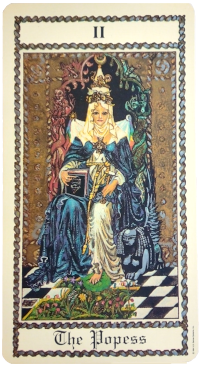


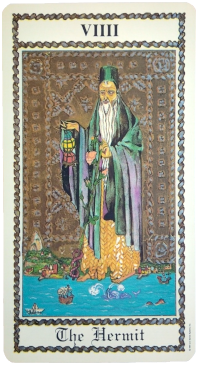



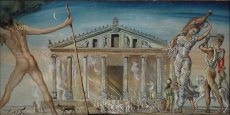 The headdress in Justice VIII reminds of the three doors in the top area of Artemis' temple, the Greek hunter goddess. The painting title is Temple of Ephesus (Salvador Dalí. 1954. Oil on canvas).
The headdress in Justice VIII reminds of the three doors in the top area of Artemis' temple, the Greek hunter goddess. The painting title is Temple of Ephesus (Salvador Dalí. 1954. Oil on canvas).
 The card is based on Death of Adam (Piero della Francesca. 1452).
The card is based on Death of Adam (Piero della Francesca. 1452).IV. Suit of Swords
Associations White is the color of the suit, and Spring time is the season. The handles usually include very meaningful elements, such as a statue of Victory, vampires, harpies, postilion horns, veiled figures, the traitors to the Caesar, a fox head, the ancient swastika cross and an eagle's head. The suit also displays the Chinese yin-yang symbol in four cards (Ace, Two, Three and Knight).
Cards relations 1) The author explicitely relates card Three with The Fool, in which a young character is walking like that of card 0, after being sent away by three relatives. The swords' handles in card Three also represent The Fool of other decks (Visconti-Sforza, Marseille and Mantegna), so the relatives of the young man might also be alluded to by them; 2) The Nine of Swords is related to the Page and Queen. Card Nine is mainly about a sarcophagus with the Page on the right side although old aged, demented and huddling in a knot. And the sarcophagus is made of red sandstone, like the base where the Queen is perched on.
Deities The suit doesn't allude to any.
Animals A serpent, a fox, a pig, horses, a crow, night birds, a fly, a black cat, a red dragon, and a swan.


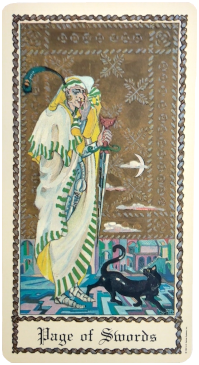

 It includes the religious votes, stigmata and pose of St Francis of Asis praying (Bartolomé E. Murillo. 1645-50. Oil on canvas).
It includes the religious votes, stigmata and pose of St Francis of Asis praying (Bartolomé E. Murillo. 1645-50. Oil on canvas).
 Based on The Conversion of St Paul on his way to Damasco (Caravaggio. 1600. Oil over cypress).
Based on The Conversion of St Paul on his way to Damasco (Caravaggio. 1600. Oil over cypress).V. Suit of Cups
Associations. The suit is associated to blue-green colors and Summer season.
Cards relations. The man in card Two is associated to the Vatican's guard in the Page (same color cloths). Bu the cup the latter holds is the opposite representation of those in card Two: it displays two lovers too, although they're not together in desire and passion anymore but only as angels.
Deities. Silenus (tutor of Dyonisius the god of wine, and son of Pan the patron of shepherds and flocks) is depicted as a drunk man in card Four. Eros (the god of love) is a blind man in the same card.
Animals. A cat, a serpent, horned dolphins, a pigeon, a cicala, a mouse, a spider, seahorses, an eagle, a frog, and a mule.





 A nun rests in the same position as the goddess in The birth of Venus (Boticelli. 1485. Tempera on canvas).
A nun rests in the same position as the goddess in The birth of Venus (Boticelli. 1485. Tempera on canvas).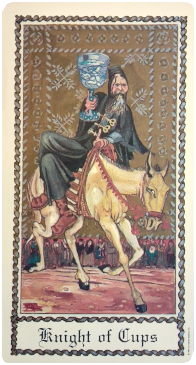

 It resembles Pope Leo X (1475-1521) in the painting by Agnolo di Cosimo di Mariano (1565-69, oil over tin). The Pope said: "God has given us the papacy, let us enjoy it" (Cite from Rendina, C, (2013). I papi. Storia e segreti. Roma. p. 614). The Mona Lisa is painted on the floor, St Peter's Cathedral in the background, and a bust of Venus of Milo aside.
It resembles Pope Leo X (1475-1521) in the painting by Agnolo di Cosimo di Mariano (1565-69, oil over tin). The Pope said: "God has given us the papacy, let us enjoy it" (Cite from Rendina, C, (2013). I papi. Storia e segreti. Roma. p. 614). The Mona Lisa is painted on the floor, St Peter's Cathedral in the background, and a bust of Venus of Milo aside.| Cards & Cups | |||
| Ace | a font on ice and shells, with a pearl at the center; it has a sinuous support made of a dragon's tail, a turtle's shell and a heart; a hexagonal bowl has fruits and swan's feathers in the outer side | ||
| 2 | a couple splitting apart (associated to serpents), and a satyr next to a nymph (associated to a lion) | ||
| 3 | black cup (recovery), white cup (accomplished work) and golden cup (transmutation) | ||
| 4 | fear to repressed tendencies, blind erotic love, drunkenness, mirages in the desert | ||
| 5 | green liquid with cabbalistic letters | ||
| 6 | living the old age: counting rosary beads, licking drops of pleasure avidly, hedonism and sensuality, practicing magic, knitting socks like a witch, meditating as an ascetic, praying like a monk | ||
| 7 | stimulating liquors, love of an old age couple, distilling opium smoke, ghosts, divine lotus, clouds, Etruscan-like face | ||
| 8 | subjects in life: confession, theater of puppets, procession with flowers trail, a hunting eagle, the occult, fears, prison, possession | ||
| 9 | pregnant women | ||
| 10 | towers-temples and the entrance to a prosper city through a pit | ||
| Page | two lovers kissing each other | ||
| Knight | Cupid folding the right elbow | ||
| Queen | green colored, winged, with Cherubs-like head | ||
| King | shaped like the papal tiara | ||
VI. Suit of Wands
Associations. The suit especially displays red color, and is associated to Autumn season and the working class.
Cards relations. Scapini just mentions one: the servants in the Six and the Page share the same livery, although the first ones are still serving and the second one is now freed (although still carries an unchained fetter).
Deities. Hercules is displayed as a divinized heroe in the Ace.
Animals. It only includes a cat in the Queen.
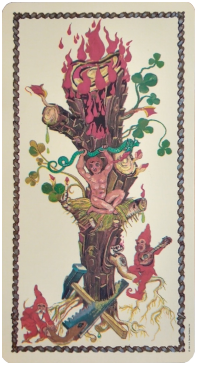

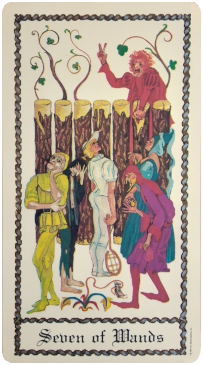
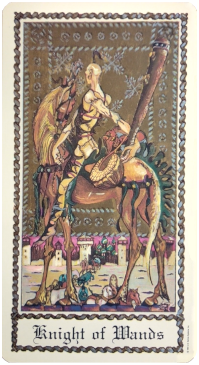
VII. Suit of Coins
Associations. It's a golden color suit, and related to Winter season. It also usually displays rooted coins, as if the source of wealthness would be very important. The artist drawned them as rocks, crystals, spirals, tubers, charms, jewels, rolled or open papers (Six), and even as planets (Eight) and the steps towards a castle (Ten).
Cards relations. 1) Card Seven is associated to the four Pages of the deck, who are seated around a game table, between 7 coins in a 3-column distribution: the Full Moon, a lyle flower and a grown tree are placed on the right side of a winner figure; the left column is related to material wealth although there's a sleeping boy and a soul in purgatory; in the central column, Saturn's chariot, a planet that Scapini assigned to Judgement card; 2) In card Nine, a sinuous pathway leads to trouble as more coins are founded on the road. At the beginning is the Page of Swords, Brighella, described by the author as "a smart villain who would do anything for money".
Deities. The suit gathers the planets known at the Middle Age. Mercury (the messenger of gods) is in cards Two and the Page, Venus (the goddess of love and arts) is in card Three, Mars (the god of war) is in card Five, Jupiter (the greatest one among the deities) in card Six, and Saturn (the god of time) in card Seven.
Animals. The suit of Coins includes more animals than the suit of Wands although much less than the other two suits: there's an ox, a lamb, a swan and a cat.

 Inspired by the painting Susan and the olds, (Gentileschi. 1610. Oil on canvas). Susan was married to Joachim, a rich and influential jew in exile. Desired by two ancient judges, the old men were planning to harass her.
Inspired by the painting Susan and the olds, (Gentileschi. 1610. Oil on canvas). Susan was married to Joachim, a rich and influential jew in exile. Desired by two ancient judges, the old men were planning to harass her.

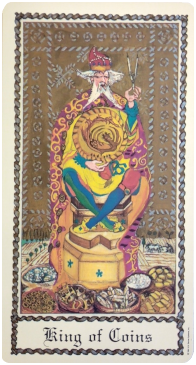
 The head of the king resembles Francesco Morosini's portrait, a militar, senator and duke of Venice in the XVII c., who fought against the Muslims of the Ottoman Empire.
The head of the king resembles Francesco Morosini's portrait, a militar, senator and duke of Venice in the XVII c., who fought against the Muslims of the Ottoman Empire.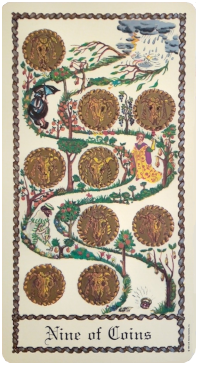


| Cards & Coins | |||
| Ace | garden of Hesperides | ||
| 2 | Mercury and a library | ||
| 3 | Venus' chariot, the Caesar and a dancing figure with a drum (in Mantegna's Tarot, the instrument is associated to Eratus, the muse whi "awakes desire" and rules erotic poetry and love) | ||
| 4 | the Moon's chariot, a swan swimming in moonlight, a boundary wall of a castle, a cat in a cage | ||
| 5 | Mars' chariot and the 4 elements unleashed | ||
| 6 | misery, Jupiter's chariot, a wanderer who has nothing and another one who has won, a rose, a provider rich man who steps on the upper step of a ladder | ||
| 7 | a sleeping child, a chest with gold treasures, a soul in purgatory praying to be freed, Saturn's chariot, the full Moon, a lyle, a wild tree with fruits | ||
| 8 | The Magician and other major arcana with planetary associations: The Popess and Moon, The Empress and Venus, The Emperor and Jupiter, Strength and Mars, The Star and Mercury, Judgement and Saturn, The World and the Sun | ||
| 9 | goats' skulls | ||
| 10 | family tree made of oak with male faces | ||
| Page | Mercury | ||
| Knight | turtle | ||
| Queen | mother breast-feeding two babies, like the figure inside of the fountain in the Ace of Cups | ||
| King | phoenix (animal associated to virtue Hope, card 39 of Group B in Mantegna's Tarot) | ||
Sources: Nueva tribuna, Alchemy Website.





Comments
Join and leave a message. I always answer personally, and as soon as possible.